Outdoor Cats, Wildlife And Human Health
INHUMANE SOCIETY REVISITED: OUTDOOR CATS, WILDLIFE & HUMAN HEALTH
Many advocates of trapping, neutering, vaccinating and releasing cats (TNR) claim that this saves these cats’ lives because they are too wild to be adopted and would otherwise be euthanized. They go on to argue that these cats adapt and find their place in the environments/ecologies where they are released. They also contend that cats play a vital role in controlling rodents that can carry diseases harmful to people, such as the plague or Black Death that in the mid -1300s wiped out one-third of Europe’s population.
This deep scar on the human psyche, passed on from generation to generation is one of the justifications used to rationalize releasing cats into our communities for our health’s sake to control “vermin”. Another justification, according to one (pro-life?) advocate of the “No Kill” animal shelter movement is that “We really need outdoor cats because in most places there are no natural predators to control wildlife.” Yet we have owls, hawks, red foxes and coyotes in our neighborhood, now competing with TNR cats released by our local humane society to fend for themselves through Minnesota’s harsh winters. Many may become food for coyotes.
This same No Kill advocate also asserted that “These cats killing birds like sparrows and starlings that were introduced here from Europe will help native birds recover.” Does this mean cats know the difference in their catch-as-catch can survival mode between native and non-native species?




Cats were once blamed for causing the plague and were exterminated in several European communities, yet this did not stop the plague’s spread just as their presence made no significant difference in stemming the pandemic and pandemonium. TNR cats are not likely to help prevent a potential pandemic disease like the Black Death because many cats are not efficient rat killers and prefer to kill and consume smaller rodents and song and ground-nesting birds, reptiles and insects. And, more significantly, the Black Death, the plague caused by Yersinia pestis, most probably came not from infective rat fleas but from human fleas and lice transmitting the disease from person to person, rats and cats having little if any involvement.
Cats can get the plague and potentially carry infective fleas from rats (and rabbits), to humans, especially if they are indoor-outdoor cats. Would a colony of TNR cats really play any significant beneficial public health service in any community this regard, or actually pose public health concerns from other diseases transmissible to humans such as rabies, visceral larva migrans and toxoplasmosis? Indoor-outdoor and feral cats can also harbor ticks which can cause Lyme disease, babesiosis and other potentially fatal human diseases. Cats can certainly help control rodents around grain and feed storage areas but there are none in most places where TNR cats are being released, including the suburban residential community of Golden Valley, MN where the authors live and where wildlife are at risk from outdoor cats
Advocates of TNR and organizations like The Animal Humane Society (AHS) in Minneapolis which calls its TNR program a Community Cat program of “RTF” (Return to Field) also insist that releasing vaccinated and neutered cats helps reduce the cat population by keeping other cats in the surrounding area away from where the TNR cats are being released. There is no scientific evidence to support this hypothesis beyond relatively isolated sites like a college campus. With massive cat-catching drives coordinated municipality by municipality, suburban community by community, city-block-by-city-block and industrial “park” office and warehouse complex-by-complex and releasing large numbers of neutered cats close around the same time (otherwise resident cats will simply relocate and become a multiplying problem elsewhere) this would obviously mean fewer cats being born in a given area. Also problematic is that these RTF cats are not tested and treated for parasites which could be a public health risk and are not tested for feline leukemia and immunodeficiency virus infections which could put other cats at risk.
There are no large-scale inter-municipal efforts in most parts of the U.S. today and failure is inevitable without cat-owner education and strict enforcement of laws prohibiting owned and non-neutered cats being allowed to roam free and breed. Regardless, many cat owners are firm in their belief that their cats do best as indoor-outdoor animals, a belief as self-serving and harmful as the unconditional advocacy of TNR which causes much suffering, probably worse than death, for those poor “unadoptable” cats caught up in their own plague and an inhumane society game of outdoor cat exploitation and cruelty. (For earlier examples see Inhumane Society: The American Way of Exploiting Animals by Dr. Michael W. Fox. St. Martin’s Press NY 1990). All TNR programs, releasing cats to roam outside of an enclosed area (wherein they should receive proper care) violate the animal health and welfare, environmental and wildlife protection and public health mandates of bioethics and One Health policy and praxis*.
The Animal Humane Society also informed us that “people in your neighborhood feed our Community Cats who help reduce the cat population where you live” but declined to tell us who does the regular feeding and inspection. These cats are regarded as “wild animals” by the humane society and local police dept. yet the MN Dept. of Natural Resources discourages people from feeding wildlife and some municipalities have ordinances prohibiting the feeding and encouragement of wildlife. Certainly, putting food out for free-roaming, feral and TNR “Community Cats” will attract raccoons, opossums and other indigenous wildlife and provide a food-source of cats for increasingly omni-present coyotes.
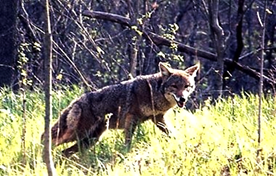
Outdoor cats are prey for coyotes now expanding into urban, suburban & rural communities across the U.S.
As a veterinarian and former Scientific Advisor and Vice President of the Humane Society of the United States (HSUS) in Washington DC co-author Fox always opposed TNR on humane grounds for those cats evaluated as “unadoptable” where the alternatives of group-housing in enclosed colonies is preferable, as per those of Pro Animale in Europe, and if not available, then euthanasia for humane, public health and wildlife protection reasons. As we have learned from personal experience, many such cats are amenable to human socialization and testing cats just caught and taken into a shelter will understandably show defensive-aggressive behavior out of fear. This should not lead to their immediate rejection as “unadoptable” and being released back where they were found. Their recovery/socialization for adoptability takes time and patience, and when in group-housing situations they will often lose their fear and come to trust people especially when they see other cats in the enclosed colony enjoying human contact and displaying affection.

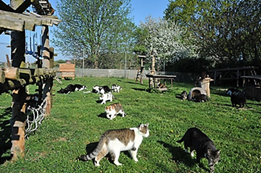


Multi-level, indoor-outdoor group housing for stray cats, Pro Animale für Tiere in Not e.V. - Home | Facebook https://www.facebook.com › Places › Schweinfurt, Germany
Many cities are embracing TNR under the endorsement of the HSUS which should be held accountable for advocating one of the most inhumane practices of the 21st century. We are appalled that the HSUS actually endorses and promotes TNR which we consider antithetical to the mission and ethics of animal welfare and protection organizations and which we see as pandering to the pro-life-no-kill sentiment sweeping the country and as self-serving, not wanting to lose donors who love cats and who believe TNR programs are the best solution to what many biologists regard as a plague of free-roaming cats. No TNR program can be effective in communities where people with cats do not have them neutered and allow them to roam free off their properties—and breed, kill wildlife, and get killed, injured or diseased. Even if some TNR cat “colonies” are being regularly fed, cats will still kill, and any becoming sick or injured cannot be provided adequate veterinary treatments.
According to the LEAGUE OF MINNESOTA CITIES INFORMATION MEMO Animal Regulation in Cities:
VI. Regulation of cats Section IV, Animal regulation – general information. In addition to the general requirements already discussed earlier in this memo, cities may impose requirements for care of cats by ordinance. “Outdoor Cats: Frequently Asked Questions,” Humane Society of the United States. Often the most problematic cats in the city are feral cats. Feral cats are from the offspring of lost or abandoned pet cats or other feral cats who are not spayed or neutered. These cats were never pets and do not have owners. (In comparison, stray cats are pet cats that have wandered off or gotten loose). RELEVANT LINKS: League of Minnesota Cities Information Memo: 4/10/2018 Animal Regulation in Cities Page 29 Feral cats are not tame like pet cats and can be difficult to handle. Feral cats can threaten the health, safety, and general welfare of the city. Some of the more common concerns include:
- Noise from fighting or mating cats.
- Foul odors from cats marking their territory.
- Flea infestations. • Multiplying numbers of feral cats.
- Visible suffering and death of kittens and cats.
Cities may take action to deal with feral cats.
A. Feral cat trapping programs “Outdoor Cats: Frequently Asked Questions,” Humane Society of the United States. If cities choose to take action on the feral cat issue, it is often done by adopting a program. A “Trap-Neuter-Return” program is recommended by the Humane Society of the United States (HSUS). italics ours). At a minimum, this program includes spaying or neutering, giving rabies vaccinations, and surgically ear-tipping. (Ear-tipping is the universally recognized sign of a cat that has gone through this sort of program). The positive results from this program include:
- Reduced mating-related fighting and other related noises.
- Neutered or spayed feral cats roam much less and are less visible and less prone to injury from cars.
- Reduced foul odors (neutered male cats are no longer able to produce the stinky spray used to mark territory).
- Reduced reproduction activity leads to fewer feral cats being born, resulting in a lower population over time.
Some cities will have city employees trap cats. Other cities will enlist the assistance of the residents in trapping cats. Cities may provide the traps for residents to pick up. Cities can accept feral cats that were trapped by residents and brought to designated spots, such as the animal control authority.
B. Feeding bans “Outdoor Cats: Frequently Asked Questions,” Humane Society of the United States Sometimes cities will impose “feeding bans” that prohibit residents from feeding feral cats with the idea that if the cats are not fed, they will go away. While this seems like it would work, it often does not. One reason relates to enforcement. Feeding of feral cats is not easily observed behavior so it is not easy to enforce a ban. Further, some people do not like to see animals suffering and will feed the cats despite the ban. Even if people are not intentionally feeding them, feral cats can still find food from other sources like dumpsters and garbage cans. RELEVANT LINKS: League of Minnesota Cities Information Memo: 4/10/2018 Animal Regulation in Cities Page 30 “Outdoor Cats: Frequently Asked Questions,” Humane Society of the United States Feral cats can often survive for weeks without food (italics ours) and, since they are territorial animals, they will not quickly or easily leave their territory to look for new food sources. Instead, they tend to move closer to human activities as they grow hungrier and more desperate. Malnutrition makes them more likely to succumb to parasites, like fleas, that can spread into houses, garages, and businesses. Finally, malnourished cats are likely to continue to reproduce, resulting in malnourished kittens, causing this cycle to continue.
C. Disposition Section III-B, Disposition of animals. Some cities will choose to dispose of feral cats that have been captured instead of spaying or neutering and returning them. If the city chooses this method, it should dispose of these cats in a humane manner. (END)
NOTE: No mention is made about feeding and caring for TNR cats, tending the sick and injured or for re-vaccinating them especially against rabies.
One reader of Fox’s nationally syndicated newspaper column Animal Doctor was an enthusiast of TNR for some years but wrote to us that he eventually gave up in disgust and out of pity for these poor cats, stating:
”Prior to 1990s, TNR was considered illegal and was underground. What Animal Care & Control did regarding stray cats or dogs was rounding them up and having them euthanized (which is the humane thing to do in my opinion). Unfortunately since 1990s, things have gone backwards. TNR has become increasing popular because of the so called “No Kill” movement—- I don’t think TNR people are bad people at all. I did it for 3 and a half years myself. I know the intention of TNR people is good. I know my intention when I did TNR was a loving intention: I just wanted to help those poor cats. Maybe that’s why my philosophy changed over time having witnessed personally what could happen to these outdoor cats: getting hit by cars, getting killed and sliced under car hoods, fleas, ticks, parasites, ear mites, worms, infections, getting shot or poisoned by people, trapped in garages or places they cannot get out, freezing to death or suffer cold related symptoms like hypothermia and losing paws, the list goes on and on. My main issue is once you release them, it is highly unlikely and impractical to help them again when they need medical attention whether they are abandoned back onto the streets, backyards or even farms. Most of these outdoor cats don’t die of a humane death. If they are lucky enough, they get hit by a car and die instantly. But many times they likely die of a slow and agonizing death from diseases, infections etc. I think we live in a death fearing and death denying society. I think the issue with the “No Kill” movement falls under that umbrella. I think No kill shelters are horrible because once they are full, they turn away animals. Some people then just simply abandon their animals on the streets, in the woods, and sometimes even leave them behind in the homes after they are evicted. To me “No Kill” people lack a level of empathy because they operate from an ideological purity perspective, rather than from an empathy perspective for the animals such as feral cats. The reason I have the perspective I do is because I put myself in the feral cats’ perspective and all the struggles they to go through to get their basic needs met, food, water, shelter and medical care etc. To me the situation is clear: feral cats have a hard, short and suffering life on the street. If I can help them by bringing them indoors, I will do that. If I’m not able to, at least I could help end their suffering through euthanasia.” (email from Paul Zhang, May 1⁄18).
Veterinarians in the U.S. and U.K. have been recently discussing managing “moral distress” in companion animal practice. Certainly emotional distress coupled with the moral dilemma of euthanizing healthy but temperamentally unadoptable cats ( and even dogs considered dangerous who can end up incarcerated their entire lives in No Kill shelters) is a professional challenge but should not lead to the unconditional endorsement of TNR as an alternative to ending the lives of cats humanely rather than opting ( for emotional rather than bioethical reasons) to neuter and vaccinate them and release them to fend for themselves outdoors. The same must be said about those many people who support TNR, putting their own emotion-governed values and beliefs over the emotional and physical well-being of the cats for whom they claim to love. The domestic cat deserves our respect and empathy and should not fall victim to the misguided, feel-good sympathy of home-owners feeding stray cats at their doorsteps and animal rescue/ sheltering “humane” societies setting neutered ones back into our communities all under the questionable authority and unqualified encouragement of the Humane Society of the United States. State veterinary, public health and wildlife conservation and management authorities and organizations need to address this serious issue without further delay for the good of all.
For further reading see:
Dr John Read | Wildlife Ecologist interview MAR 2020 · AUSSIE WILDLIFE SHOW on the threat of free ranging cats in Australia and cat control methods restoring ecological balance. Talks about the threat to humans -details toxoplasmosis. His book “Among the Pigeons, Why Cats Belong Inside” advocates for keeping pet cats indoors with a chapter on how TNR is ineffective. https://podtail.com/pt-BR/podcast/aussie-wildlife-show/dr-john-read-wildlife-ecologist/
Maybe Rats Aren’t to Blame for the Black Death - National Geographic (https://news.nationalgeographic.com/.../rats-plague-black-death-humans-lice-health-sc...).
Anne Fawcett & Siobhan Mullan,2018, Managing moral distress in practice, Veterinary Record, In Practice, 40: 34-46
Why I Am Against Trap Neuter/Spay Release (TNR) For Feral Cats (http://web-dvm.net/why-i-am-against trap-neuterspay-release-tnr-for-feral-cats/)
http://www.hahf.org/awake/the-trouble-with-trap-vaccinate-neuter-return/
*See M.W. Fox Healing Animals & the Vision of One Health. Create Space Books, Amazon.com 2011.
FERAL CAT RECOVERY FROM THE WILD
Photo montage of “Mr. Sammler” trapped on our property in Golden Valley MN by Fox & Krantz, * Dec.27, 2015-March 7, 2016. First seen in the summer, eventually trapped, neutered, tested for feline immunodeficiency and feline leukemia virus, treated for round and tape worms and fully vaccinated. Estimated 18 months old. Gradually acclimated to us and resident ex-feral cat who served as a socializing catalyst.
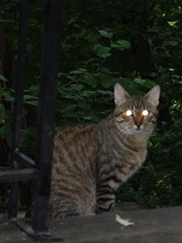
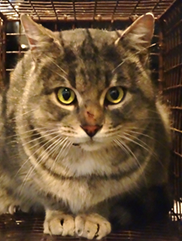
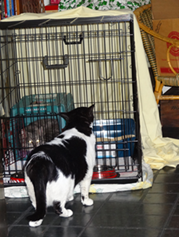
Summer night hunter, then caught in trap (portrait through the wires) then in-house holding cage meeting resident ex-feral cat
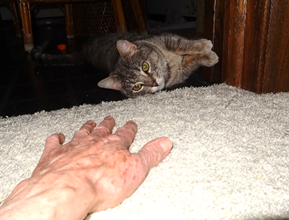

Tentative social interaction begins 2 weeks after release from crate, kept open in cat’s “safe” room.
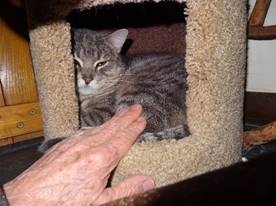
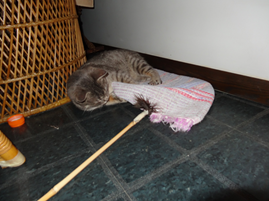
Secure in cubby-hole, after 2 weeks accepts being touched and later, paw massage; plays with feathers on a cane under rug
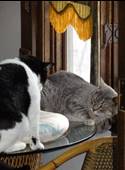
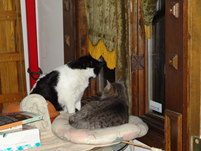



Submits to resident cat, bonds looking outdoors at bird feeders and sleeping together; after 4 weeks enjoys interactive play and stroking with feather-cane and plays under carpet with feather cane and resident cat
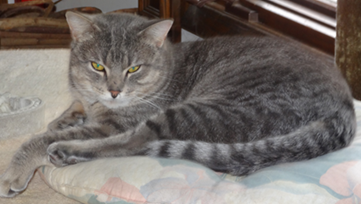
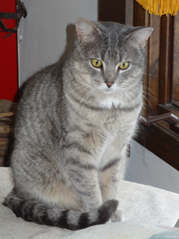
Mr Sammler, 8 weeks into recovery; a magnificent Silver tabby landrace, adapting well to life indoors
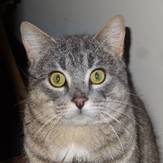
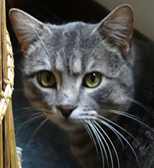

Mr. Sammler’s eye talk: Surprise and curiosity, fear and insecurity, trust and acceptance